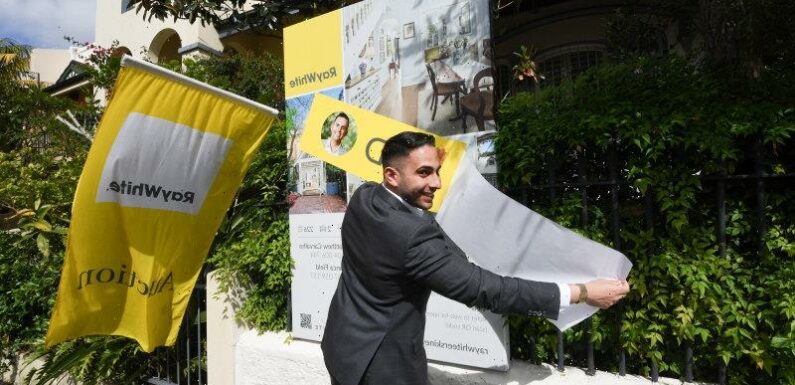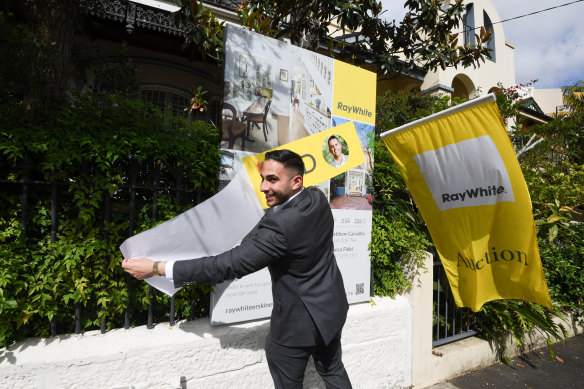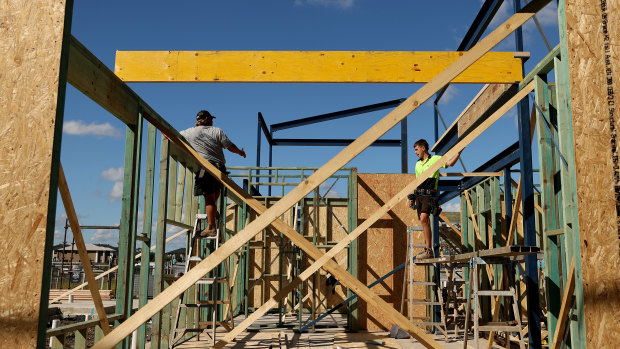
The Reserve Bank could use its first meeting of the year to deliver a super-sized 0.4 percentage point lift in official interest rates with the nation’s biggest home lender predicting the RBA’s aggressive tightening of monetary policy is now starting to bite across the economy.
While most economists and financial markets expect a rise of 0.25 percentage points, the Commonwealth Bank believes there’s a one-in-four chance the Reserve will use its Tuesday board meeting to take the official cash rate to 3.5 per cent, which would add at least another $150 a month to the monthly repayments on an average-sized home loan.
The Reserve Bank may push up interest rates by 0.4 percentage points at its first meeting of the year on Tuesday.Credit:Peter Rae
The RBA started lifting the cash rate, currently 3.1 per cent, in May last year after taking it down to a record low of 0.1 per cent in late 2020. Before tomorrow’s decision, the annual repayments on a $758,000 mortgage will have climbed by almost $16,000.
Gareth Aird, the Commonwealth Bank’s head of Australian economics, said he expects the RBA to inflict another quarter percentage point rate increase on borrowers, but there is a strong chance it could go further. He said the breadth and size of the lift in inflation through the December quarter meant the RBA was likely to look at a 0.4 percentage point increase.
According to Aird, if the bank took the cash rate to 3.5 per cent this week it would then be able to sit back over coming months to determine how the tightening of monetary policy was affecting the economy.
“We think the case to raise the cash rate by 40 basis points to a conventional metric of 3.5 per cent, coupled with a stated intention to hold the policy rate steady over the period ahead will be on the table,” he said.
“We think that the RBA is close to pausing in their tightening cycle.”
In December, the average loan in NSW lifted to $758,000 while in Victoria it increased to $624,000, its highest level since the middle of last year. Nationally, the average loan was $604,000.
A 0.4 percentage point lift in the cash rate, if passed on by commercial banks, would add $189 a month to an average NSW mortgage and $156 to an average Victorian loan. Nationally, repayments would lift by $152.
Aird said the RBA, which will this week update its forecasts for the economy, is likely to downgrade its expectations for growth as higher interest rates start to bite. Retail sales for December showed a substantial 3.9 per cent drop in the most important shopping month of the year.
The Australian National University’s shadow Reserve Bank board, which expects another quarter percentage point lift in rates on Tuesday, believes the economy is holding up better than expected to previous rate increases.
“While there are signs that past interest rate increases are slowing the economic activity, the Australian economy, in particular the labour market, remains quite strong,” it said.
While the property market has cooled sharply since the Reserve Bank started lifting interest rates, the rental market has suffered a sharp increase in asking rents. Rental vacancy rates have fallen in many parts of the country to 1 per cent or lower.
This week, the government will introduce the legislation for its $10 billion Housing Australia Future Fund that will be used to provide ongoing funding for new social and affordable housing.
The government will introduce its housing future fund to parliament this week, aimed at boosting social housing supply.Credit:Bloomberg
Housing Minister Julie Collins said the fund would be a step toward addressing issues such as high rents while also supporting the construction sector.
“The $10 billion Housing Australia Future Fund will create a stream of funding to ensure there is a pipeline of new social and affordable housing. It will also be a shot in the arm for our construction industry, keeping tradies on the tools,” she said.
But in its submission to Treasurer Jim Chalmers for the May budget, Homelessness Australia said the government had to go further than the future fund.
It wants the creation of a $2 billion “rapid re-housing fund” to deal with immediate housing issues, an expansion of the future fund to support the construction of 25,000 social homes a year and a 50 per cent increase in Commonwealth rent assistance.
Homelessness Australia chief executive officer Kate Colvin said since Labor promised to deal with the nation’s housing crisis last year, the supply and affordability of rental housing had got worse.
“People are being outbid for crumbling properties on the spot, sometimes by hundreds of dollars,” she said.
“With an extremely tight vacancy rate, the market for rentals is simply galloping away, especially for people on low and middle incomes. Parents are trying to supervise their kids’ homework while living in tents. In a wealthy, developed nation, this is simply unfathomable.”
Cut through the noise of federal politics with news, views and expert analysis from Jacqueline Maley. Subscribers can sign up to our weekly Inside Politics newsletter here.
Most Viewed in Politics
From our partners
Source: Read Full Article

